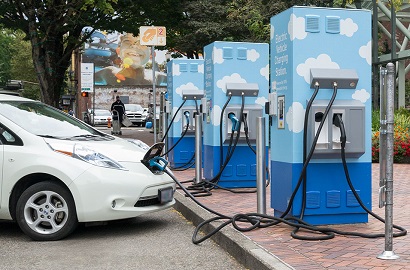Charging stations increase to 153,927
Oregon Senate President and key sponsor, Rob Wagner (D-Lake Oswego), proudly announced passage by the House of
SB 582, which requires greater safety and training standards for electric vehicle (EV) charging installations. Over the course of the next five years, the Oregon Department of Transportation (ODOT) is projecting to invest $100 million from both federal and state sources to increase EV charging infrastructure with two-thirds of the funding coming from the 2021 Infrastructure Investment and Jobs Act.
"This bill positions Oregon to take advantage of federal investments in EV charging infrastructure," said Senate President Rob Wagner (D-Lake Oswego), co-chief sponsor of the bill. "By setting high standards for safety and training we will ensure state dollars are used effectively to create high quality infrastructure for Oregonians."
Oregon is anticipated to require 153,927 public electric vehicle charging ports by 2035, a more than 4,500% increase from the number of ports in 2020. That’s 1.6 for every square mile in Oregon, and a lot more if you reduce it for water and wilderness. There are currently 480 DC fast charging stations in Oregon. These high-power chargers can fill an EV to near capacity in about 20 minutes. Can you imagine your gas fill-up line taking 20 minutes each?
While devoid of carbon monoxide or other stinky pollutants, high-tech electric cars are instead emitting a gasless pollutant: Electromagnetic Field radiation, or EMF radiation. EMF radiation is a low form of energy released by any piece of technology with a plug or a battery that uses an electric current to function. Science has proven that extended exposure to these emissions cause adverse health effects, thus a highly padded cover when dental x-rays are taken.
Even low levels of frequent exposure can cause biological effects in humans and the environment. Long doses include cell damage, DNA fragmentation, fertility problems, miscarriage, cancer, and neurological effects that can lead to health disorders and behavioral issues. Some symptoms of radiation poisoning are loss of smell, loss of taste, hair loss, nausea, brain fog, etc.
Electric cars are not built to shield passengers from EMF. A big battery is being used close to passengers, with electronic circuitry running around the edge of the cabin. This increases the amounts of radiation exposure. When charging, the EMF radiation emitted from the charger is greater than ICNIRP standards of radiation levels. Even fuel vehicles have over 50 electronic control units that emit EMF radiation, including Bluetooth connections, push-button starts, car alarms, and dashboard controls.
A D V E R T I S E M E N T

A D V E R T I S E M E N T
This whole idea of pushing electric vehicles is to decrease carbon emissions to zero by 2030, which is simply unattainable and they know it. Approximately 40% of global CO2 emissions are emitted from electricity generation by the combustion of fossil fuels to generate heat needed to power steam turbines. The demand that we stop using fossil fuels replacing it with renewable electricity options, is their agenda’s pathway to condemn humanity to poverty and control.
Oregon is reported to be a top seller of EV in the U.S. and China is
reported to be leading globally in sales of their electric vehicle - NETA cars. However, a field was discovered with over 10 thousand EV cars, all 2021 models having less than 3,100 miles on them, and fully registered to count in their sales numbers. China accumulates these cars in a Ponzi investment scheme.
SB 582 passed the House and is being sent to the Senate floor for a vote without a hearing in the Senate.
--Donna Bleiler| Post Date: 2023-06-21 12:08:07 | Last Update: 2023-06-23 09:30:07 |







